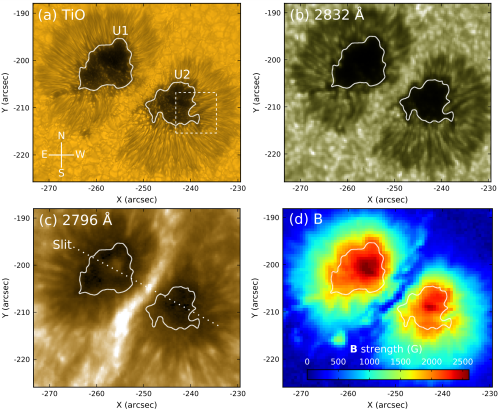Master’s student, ZHANG Xinsheng, and Professor YAN Xiaoli with their collaborators from the Fuxian Lake Solar Observatory at the Yunnan Observatories of the Chinese Academy of Science carried out a detailed study on the fine structure and driving source of the chromospheric umbral waves in sunspots. They utilized data from the Interface Region Imaging Spectrograph (IRIS) as well as other telescopes. The research findings were recently published in the international journal Solar Physics.
Umbral waves are a type of fluctuation phenomenon that occurs within the umbrae of sunspots. Based on their morphological structures, the fine structures of umbral waves can be categorized into ripple-like pattern and spiral wave patterns. As observational capabilities and computational power improve, more and more research suggest that the physical nature of umbral waves in sunspots is that of slow magnetoacoustic waves propagating along magnetic field lines. However, it is still unclear whether these slow magnetoacoustic waves are driven by the acoustic waves (p-modes) or generated by the magnetoconvection.
To obtain the mechanism on the driving source of umbral waves in sunspots, ZHANG Xinsheng and collaborators have studied the fine structure of chromospheric umbral waves in two sunspots within the active region NOAA 13023, primarily based on IRIS SJI 2796 angstroms imaging data. Furthermore, they have carried out a statistical analysis of the spatial distribution of the origin of these umbral waves. By tracking the motion of the spiral wave patterns, researchers have observed for the first time the simultaneous existence of two one-armed spiral wave patterns within the umbra, which can rotate in the same or opposite directions. Furthermore, by analyzing the spatial distribution of the oscillation centers of the one-armed spiral wave patterns within the umbra (the oscillation center is defined as the location where the spiral wave pattern first appears), they found that the chromospheric umbral waves originate repeatedly in the 5-9 mHz high oscillation power regions. Most of these umbral waves occur within the dark nuclei and strong magnetic field regions of the umbra, rather than the regions outside the dark nuclei where magnetoconvection is more intense. Therefore, this study suggests that the chromospheric umbral waves are likely driven by the p-mode oscillations.
This research was supported by the Strategic Priority Research Program of the Chinese Academy of Sciences, the National Natural Science Foundation of China, the Youth Innovation Promotion Association of the Chinese Academy of Sciences, and the Yunnan Key Laboratory of Solar Physics and Space Science, among other projects.

Figure 1, Observations of two sunspots in the active region NOAA 13023. (a)?GST TiO 7057 angstroms image; (b)?IRIS SJI 2832 angstroms image; (c) IRIS SJI 2796 angstroms image; (d) SDO HMI total magnetic field strength image. Image by ZHANG.

Figure 2, (a) Spatial distribution of the oscillation centers of the one-armed spiral wave patterns based on the IRIS SJI 2796 angstroms data within the umbra; (b) mean intensity map of the IRIS SJI 2832 angstroms, with red contours representing the dark nuclear regions in the umbra; (c)Total oscillation power map in the 5 – 9 mHz range computed from the IRIS SJI 2796 angstroms data.
Contact:
YAN Xiaoli
Yunnan Observatories
E-mail: yanxl@ynao.ac.cn